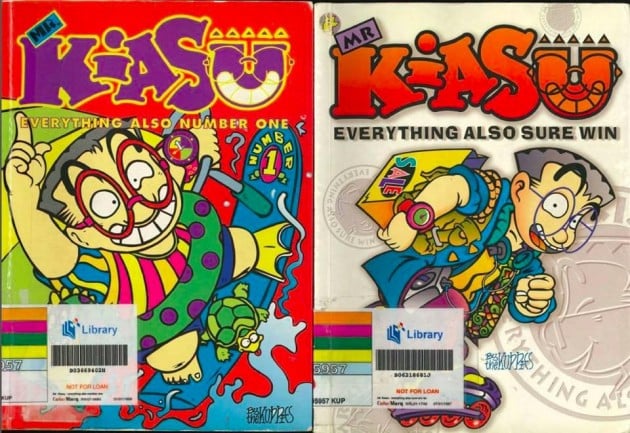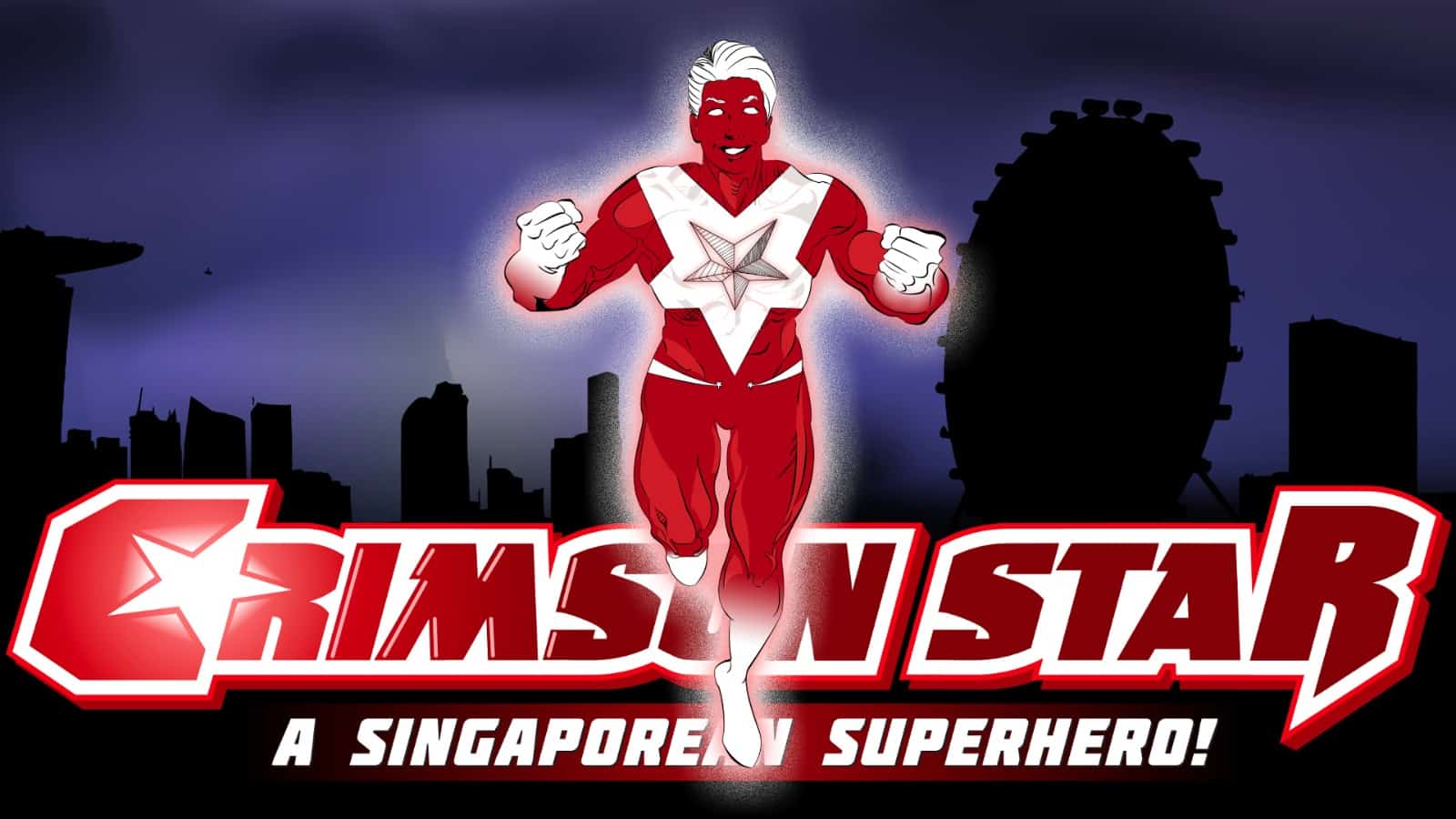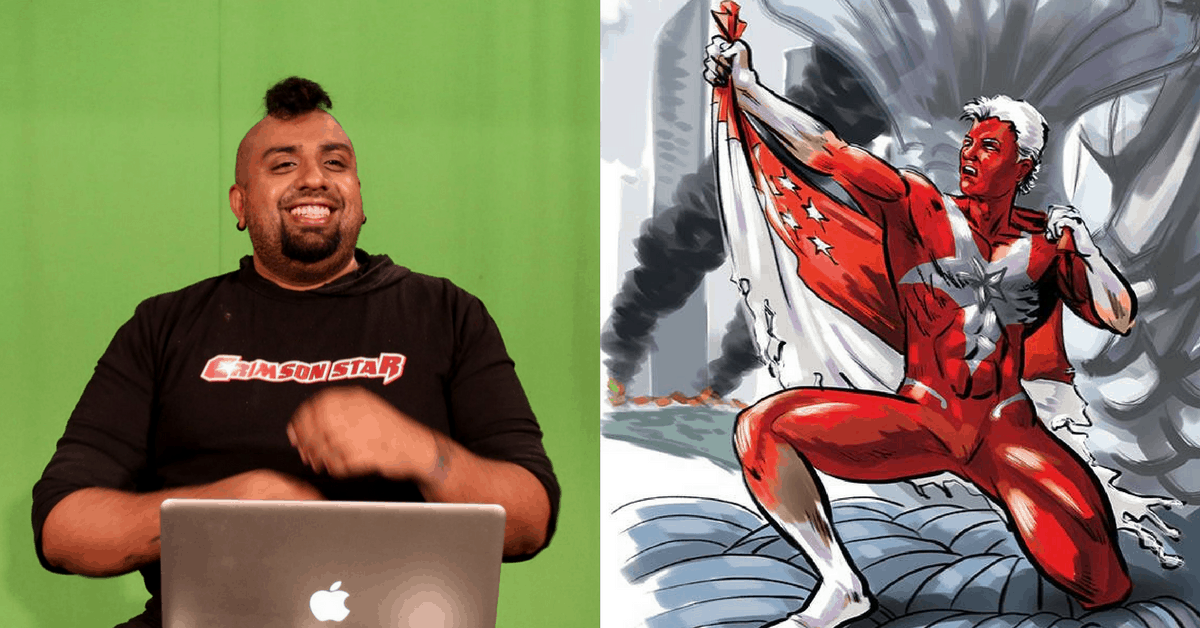It’s a familiar scene: a dastardly villain holds a vehicle full of innocents trapped in a precarious position, inches away from their death. Miles away, a seemingly mild-mannered civilian goes about his day when news of this crisis reaches his ears.
Ducking into a nondescript alley, he rips his shirt open – baring, for the audience, a bold insignia before he launches himself into the sky in a flash of colour.
Seconds later, he is engaged in a deadly battle with his foe, set against an iconic landscape, and after an intense sequence of action, he emerges victorious—innocents safe from harm and antagonist restrained.
But what if, in this familiar scene, is an even more familiar landscape: Singapore.
And this hero in question is as Singaporean as you and I, as is the creative team behind this adventure… unlikely? Enter Crimson Star.

An ongoing, unreleased superhero comic featuring a Singaporean superhero and produced entirely by local talents, you’d think that Crimson Star would be a sure-fire success. However, not everything is as rosy in the arts scene as you’d believe.
The Arts Here And Now
The Singaporean arts scene has always been subject to contention and pity. With a general increase in funds and specification from government bodies like the National Arts Council, it’s now point blank that general support for locally branded arts has taken a dive in Singapore.
Government funding has become the only breadwinning tactic available to many pioneering Singaporean artists, especially after donations in cash to the arts scene plummeted from $136.1 million in 2015 to a measly $64.7 million in 2017.
You may disagree if you’re a fan of local musicians – perhaps rightfully so, with a sudden surge in event market visibility, and most social media posts with the hashtag #supportlocal being dedicated to Singaporean bands.

The fact of the matter is that many of these posts come from the mosh pits of free gigs, and musicians aren’t pushing a Singaporean brand nearly half as much as other, niche, non-performance arts need to – primarily because they’ve got less in-your-face opportunities to work with.
Crimson Star Rising
Crimson Star isn’t Ryan’s (creator) first foray into the comic book industry. He’s been in the game since 2005, releasing two other comics independently, also working as a script doctor on some pretty big international names -names that take me an insurmountable amount of self-control to stay confidential about.

Crimson Star is his next attempt at comic-book writing in Singapore, hoping to challenge a “very cynical and jaded view that anything cool that happens in Singapore is a joke”.
The Singaporean writer hopes to use the series Crimson Star to help veer the local literary arts scene onto a different, more productive path. For the series, he sports an all Singaporean team of talents, to truly draw “distinctions between local content, and explorative local content”.
The man’s got some pretty solid plans, but as with all arts, whether this is a vessel that’s empty or full is entirely subjective.

Can You Take This Seriously?
Ryan tells me about how in Asia it’s just Singapore that’s been plagued by a lack of fictional, superhero-esque context. This is somewhat ironic, given the heightened development and towering successes that Singapore has seen as compared to its neighbours.
Most other countries in the region have their own heroes and dedicated comic-book art studios. The Philippines hosts one of Asia’s biggest annual geek conventions, the AsiaPOP Comic Con; which sees guest actors from television and blockbuster hits like Stranger Things, Avengers, Justice League and Game of Thrones.
“Local mainstream media hasn’t put out anything to make Singaporeans believe that we are capable of such output.”
He laments about a superhero TV Series that premiered in Singapore in 1998 called ‘VR Man’. “I’ve gotta admit, I loved it as a child” but as he mentions, I can’t see how a villain called ‘Click Click Man’ (based on the clicking sound a computer’s mouse makes) would’ve caught on as anything but parodic.
Parodic is fine, but only if that’s what you’re attempting.

“The writing took itself way too seriously… a very strong sense of not knowing your audience or not knowing your climate.”
This Is Really Good, For Local Content
If you haven’t thought that to yourself at least once, it’s possible you’ve been underexposed to content that’s truly branded local. Before you think i’m making sweeping statements, let’s take a look at some of what makes locally branded content.
“There’s not much content that talks about Singapore in a very sincere kind of way,” Ryan says, as he vocalizes how literary bestsellers like Mr. Kiasu were meant to be satires of Singaporeans in the ‘90s. He cites Mr. Kiasu is a product that’s “truly, good”.

His perception reminds me of a video that I came across sometime last year.
If your GIRLFRIEND acted like an ARMY SERGEANT
If your GIRLFRIEND acted like an ARMY SERGEANT.Some girlfriends are… :oLike our Facebook page to show some support! :)w/ Nancy Lnn Richie Xander Gerald Oh Si Kai Jeremiah ChenStay tuned for the next video !
Posted by Tropic Monsters TV on Thursday, 14 September 2017
This video, like other locally branded content, could come across almost like a formulaic move by a viral content artist. One that stems from the perception that the only way to pander to a Singaporean audience is with boorish, exaggerated representations of Singlish.
If you’re part of an audience that enjoys this style of content formulation, it’s also probable that you’re aware of these being mindless content tactics. Where internationally, video producers rely on other simplistic tactics for mindless social media content – this is what we rely on.
Gone are the good ol’ days when Phua Chu Kang properly utilized Singaporean colloquialism with thoughtful writing and plotlines (at least for the first couple of seasons).
Are the producers or script writers of Criminal Minds: Beyond Borders truly the only ones who should take the fall for that corny, inaccurate misrepresentation of Singapore in their episode?
Unless they’ve actually got Singaporeans on their team, research of Singaporean representation leaves them an image that’s the furthest thing from accurate.

It’s a valid discussion that Singaporean values are often not discussed in fictional contexts. Drawing from this, Ryan quotes the examples of the local superhero recommendations that he received when forming Crimson Star. One of them was ‘Anti-Ponder,’ meant to tackle the issue of Singapore’s recent flooding issues.
“There’s a very juvenile mentality when considering these, like we’re trying too hard to be funny, or like how anything we can imagine has to be related to current situation – like our biggest problem is that trains keep breaking down.”
As with comics, Ryan says that the biggest problem is that many locally-branded comics are not produced by locals, often leading to the portrayal of Singaporeans as caricatures of society. “We often tend to look like urbanized versions of Hong Kong.”
It’s almost cyclical.
Shaking A Status Quo
“I want more people to comprehend that not everything in Singapore needs to be poked fun of,” Ryan explains, selling the idea of Crimson Star as an icon that creates room for some actual discussions in Singapore.
Still, there’s no forgetting that superheroes are still somewhat of a niche. Using Singaporean branding as a sole tactic would only bite Ryan’s views in the ass. Thankfully, he has some other tropes up his sleeve.
He speaks about Singapore’s resounding apathetic culture, and a realistic portrayal of how a superhero popping up would be perceived in Singapore today.
“The character himself is a reluctant hero…he doesn’t really want his powers simply because he thinks superheroes pull unwanted attention”, a challenge especially in a universe where superheroes are prevalent in other countries.
Superheroes also mean supervillains, broadening the discussion to the question of what Singapore would be like if our peace was disrupted.

“It’s especially relevant now…global warming’s made our weather drastically change, we’ve had mini-cyclones…but in many ways, we’re still very sheltered”, Ryan says, quoting the example of how he’s lived in Singapore for all of his 30 years but has yet to be caught in a flood.
“It’s one thing when you see police officers running after a thief with T-batons, but it’s another thing when a fight between two superpowered beings means destroying a building with at least three to five casualties.”
It’s jolting reality that our only experiences of natural disasters are watching casualty counts of stricken neighboring countries.
Flying One Step Higher With $2 Comics
Speaking of a niche industry within the arts in Singapore, survivability is truly uncertain. The comic-book industry in Singapore is one that’s practically non-existent, reliant heavily on external factors such as government funding, and crowdfunding.
I ask about Sonny Liew, local comic book writer and artist who’s one of the only few Singaporeans internationally recognized in the industry. “People like Sonny are lucky, because he’s one of the very few artists who can actually write.”

This begins to explain Ryan’s adamance not to work with publishers. “None of them are solving the problem… the people who work on comics earn shit.”
According to Ryan, retailers purchase comics from publishers at a rough 50% of their cover prices, of which a fraction would go to the publisher, the remainder being divided amongst creative team of the comic – typically consisting of a writer, penciller, inker and colourist. Government funding only goes so far in defraying early costs.

Crowdfunding For A Cause
As part of his efforts to avoid working with publishers and to ensure affordability, Ryan has put his comic up on Kickstarter, to help him meet a minimal funding goal that will serve as a stepping stone to seeing his product on the accessible shelves of convenience stores and in the hands of the one people of Singapore.

He seeks to ease the burden of purchase on buyers, who typically have to spend about $5.80 on a single issue. Part of his heartwarming cause involves allowing every person, including children, to be able to purchase his comics.
“I don’t ever want to have a situation where a person has to think between having lunch, or buying this. I’d like for you to be able to buy a copy, and read it at a coffee shop as you have lunch.”
It’s clear that the medium has had a significant presence in his childhood.
He says this very bluntly – the best way for Singaporeans to support causes that they have confidence in is to “put your money where your mouth’s at.”
With the number of industry-player names he’s quoted through the course of this interview, it’s obvious that Ryan’s dabbling in an industry he’s well aware of. And with how genuinely community-driven it is, Crimson Star’s a project that needs Singaporeans’ backs only as much as it has their backs.

Ryan plans on changing his all-Singaporean art team every 3 issues, to ensure maximum visibility and opportunity for freelance artists in Singapore. It’s especially important because most artists face the requirement of being “published” if they want to go professional with their passion.
If anything, Crimson Star’s a true test of whether the hashtag, #supportlocal is merely a personal branding choice or a cause. If you’ve been looking for something to put your faith back in locally branded products, this is a solid start.

















